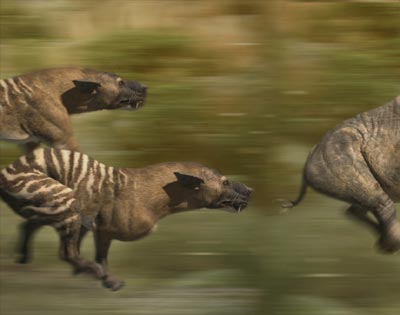Creodonta
So much for the science - what does that mean?
It means that prior to the evolutionary success of the modern carnivores like cats and dogs, the creodonts were the top predators and scavengers of the mammal world. They arose during the Paleocene (the time that followed the disappearance of the dinosaurs 65 million years ago), flourished in the Eocene (55-38mya) and were gone by the Miocene (26mya).
You may even have met creodonts before because they took a staring role in the BBC's "Walking with Beasts", see the reconstruction above of some hyaenodons taken from the BBC's interactive support for the series.
So why are creodonts of interest?
I first came across Creodonta while doing some background research when I was preparing a piece on carnivores for Jersey Zoo.
The creodonts stood out for two reasons, firstly because I came across references to saber-toothed creodonts (particular hyaenodons) and secondly because I found material that said creodonts deveoloped concurrently with the development of Carnivora and others (which I now know were based on older material) that said they were ancestral to the Carnivora order.
This immediately raises several questions:
Why would saber-toothism arise separately at least twice in modern carnivores (the saber-toothed tiger, around at the end of the last ice age only 11,000 years ago, was only one of several sabre toothed cats), in creodonts and even in a South American carnivorous marsupial?
Why was there such a plethora of land predators in the Eocene and Oligocene (55-26mya)? Not only were there Carnivora and Creodonta but there were also giant carnivorous flightless birds.
Why did only the Carnivora survive to the present
day? Indeed with the exceptions of some reptiles and the now extinct Tasmanian
Wolf the only large carnivorous land animals are members of the Carnivora
order.
In competition with birds of prey the Carnivores form the majority of
small land predators, and through the seals, sea lions and
walruses are
also aquatic predators.



